The tragic tale of Saddam Hussein's 'supergun'

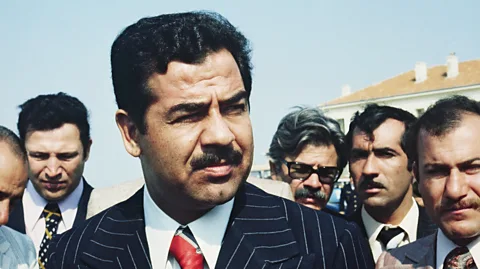 Getty Images
Getty ImagesThe biggest gun ever designed could have put Iraq at the centre of space exploration, but its story is one of unfulfilled genius, military secrets and murder.
On permanent display in the Royal Armouries’ collection at Fort Nelson, Hampshire are two huge, steel pipes bolted together and projecting high into the air. They’re enormous, big enough for someone to crawl through.
These giant cylinders are one of the few remaining pieces of a contender for one of the most audacious pieces of engineering ever designed: a “supergun” called Big Babylon, which could have fired satellites into orbit from a 156m-long barrel (512ft) embedded inside a hill.
Its Canadian inventor, Gerald Bull, who was one of the world’s leading artillery experts, had high hopes that it would revolutionise space launches, removing the need for conventional rockets. “Bull was an outstanding scientist and a charismatic figure, and this is the physical reminder of what he did on a monumental scale,” says Nicholas Hall, Keeper of Artillery at the Royal Armouries.
 WordClerk/Creative Commons Attribution-Share Alike 3.0
WordClerk/Creative Commons Attribution-Share Alike 3.0But Big Babylon was never built, and no-one has got close since. So what happened? The answer is a tale of hubris, thwarted ambitions and military secrets. At a time when Bull’s expertise should have been in high demand by all of the world’s superpowers, he chose to make his supergun for Saddam Hussein instead, a decision that would end in murder.
Decades later, tantalising questions remain: could Bull’s supergun idea have worked? And might the idea that died with him ever return?
A gifted academic, Bull began working with the Canadian and US governments researching supergun technology in the 1960s. Initially, engineers used his designs to test supersonic flight without the need for an expensive wind tunnel, by firing projectiles short distances through the barrel of a large gun. But although he would end up spending much of his career in government-funded weapons research designing rockets and guns for warring countries, his personal ambition was to use his designs to launch satellites not missiles.
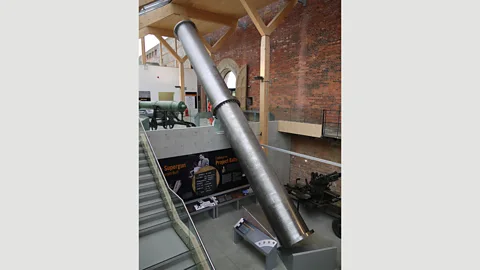 Geni/CC BY-SA 4.0
Geni/CC BY-SA 4.0“Low cost was the concept, at least,” explains Andrew Higgins, a professor at the Department of Mechanical Engineering at McGill University, Canada. “Rather than throwing away the first stage of a rocket, using a large gun for the first stage would enable this hardware to be reused and easily serviced.”
In 1961, Bull began working on the High Altitude Research Project (Harp), a joint venture between the US and Canadian governments. Using modified ex-Navy guns, Bull and his colleagues fired weather probes into sub-orbit and back down again. The costly and controversial Vietnam War meant the project was canned in 1967 before they could get any objects into orbit, but it teased Bull with the possibility of creating a satellite-launching supergun – a spacegun.
The idea appealed to Bull because it would remove the need for multiple rocket stages to reach orbit. The first moments of a conventional rocket launch require a huge amount of energy to get the rocket moving, because this is when the vehicle is filled with the most amount of fuel, and the atmosphere is at its thickest. What’s more, rocket motors are expensive.
The Harp launch guns could reach 2km/s, explains Higgins, and if you used gas to power the projectiles, you could go much faster. “They really replace the first 1.5 stages of a conventional launch vehicle,” he says.
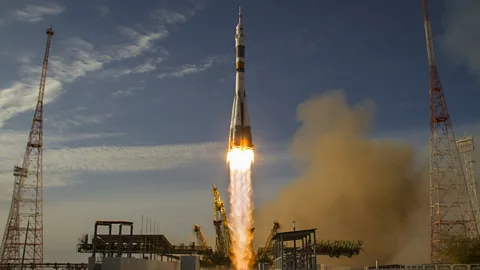 Getty Images
Getty ImagesYou might think that no satellite could survive the huge g-force of acceleration of a spacegun launch, but this is “often over exaggerated”, according to Higgins. “Military artillery shells today have GPS and laser-guidance optics and electronics that survive these accelerations, so it can be done. Obviously, not everything can be launched this way, but gun launch is well suited for launching fuel and building materials.
“Punching through the lower (denser) part of the atmosphere at high speed is an intense heat transfer problem, but ablative coatings and heat shields on the nose of the projectile should be up to the job,” says Higgins. One of the main downsides would be the sonic boom, an environmental, or even political, concern, he adds.
Bull was convinced that his supergun designs were the way forward, he just needed the funding. The problem was that by the 1970s the rest of the world had lost interest in superguns and were now looking elsewhere. To find money, Bull began to sell weapons and continued to develop his space supergun as a side project. He set up a private company – the Space Research Corporation of Quebec – and soon started selling arms to the South African government.
In 1976, Bull was arrested in South Africa for violating the United Nations arms embargo and he served six months in a US prison, wrote the New York Times after his death. On release he began selling to South Africa again, and this time was fined $55,000 for international arms dealing. Fed up with the involvement of the Canadian and US governments in his work he moved to Brussels, Belgium, and began operating through a European company.
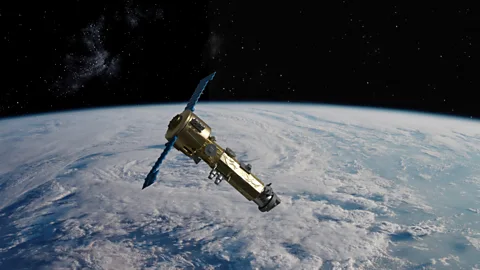 Getty Images
Getty ImagesBull was not tricky to work with, according to Hall, but he did seem to have become darker towards the end of his career – more autocratic. “I don’t think he was the archetypal mad genius figure,” adds Hall. “But he was slowly alienating himself from the Western world.”
In 1981, the Iraqi government contacted Bull to design artillery for them to use in the Iraq-Iran war. At this time, Saddam Hussein was the Iraqi defence secretary; he liked Bull and his designs after they proved vital in their campaign.
“He was particularly interesting to Hussein because he could help him with their artillery problems,” says Hall. “At the time, working with Iraq wasn’t such a strange decision because they weren’t a threat to the West. Hussein wanted to be the leader of the Arab world and show his success with their technology. He did wish for some sort of space programme, so this would have appealed to Bull. He was a great catch for Hussein as an expert.”
Finally, in 1988, the Iraqi government paid Bull $25 million to begin Project Babylon – the first true spacegun project – on the condition that he continued to work on their artillery. Project Babylon began life as three superguns; two full-sized Big Babylon 1000mm calibre guns and a prototype 350mm calibre gun called Baby Babylon. The full-size Big Babylon barrel would have been 156m in length with a one metre bore. In total it would have weighed 1,510 tonnes; far too big to be transportable, and so instead would have been mounted at a 45 degree angle on a hillside.
Big Babylon would have overshadowed all previous supergun designs for size – including guns built for military use like the giant German guns from the two World Wars and later spacegun designs – although we can only estimate other details, like launch velocity.
You can see a larger version of this graphic here (Credit: Nigel Hawtin)
Using nine tonnes of special supergun propellant, Big Babylon would have been theoretically capable of firing a 600kg projectile across 1,000 kilometres, putting Kuwait and Iran well within striking distance from inside Iraq. Alternatively, the gun could be used to launch a 2,000kg rocket-assisted projectile carrying a 200kg satellite.
To do this would have required an enormous charge. “One very considerable technical problem with a gun of this size is how you ignite the charge,” says Hall. “It burns quickly, but with such a long barrel you need a sustained release. This means you need to solve some far more complicated calculations than with smaller types of artillery.” He believes Bull could have worked it out though.
“We know roughly what the projectiles would have looked like. Something similar to an anti-tank round, where the projectile is housed in a light-weight casing which falls away at the muzzle of the gun. Beyond that, we don’t really know.”
Had Bull been able to solve these issues, the capabilities of Big Babylon would have made the supergun an attractively cheap way to launch satellites. The cost was roughly $1,727 per kilogram, adjusting for inflation. By comparison, Nasa estimates that it costs $22,000 per kilogram to launch a modern satellite into orbit using conventional rockets.
Bull wasn’t the only one who saw the potential in superguns – experiments elsewhere around the same time supported the idea that it could work. In the late 1980s, a scientist at the US Lawrence Livermore National Lab called John Hunter with a background in magnetic guns began to work on gas-powered guns with a few million dollars in funding and the project name Super Harp (or Sharp), as an homage to Bull’s earlier endeavours.
 Getty Images
Getty ImagesA powder gun like the one used in Harp and a gas gun like Sharp both work in the same basic way – expanding gases. The lighter the gases molecular weight, the faster it expands in air. Gunpowder has a molecular weight of 22, slightly less than the average molecular weight of the gases in air at around 28, but ignited gunpowder is incredibly hot, so that’s why it expands so quickly. The hydrogen used in gas guns, however, has a molecular weight of two so expands extraordinarily quickly in air.
“Harp would have used a powder gun to get [the projectile] to about 2 km/s, then used a rocket to get the rest of the way to the 8 km/s required for orbit,” says Higgins. “Gas guns (like Sharp) have proven to get to speeds of 6 km/s.” So the projectile is already travelling much closer to the required speed to enter orbit.
The benefit would be that less space would be needed for propellant to carry it fully into orbit, providing much more room for satellites, fuel or building materials.
Sharp demonstrated that gas gun technology could reach escape velocity – and Bull was aware of Hunter’s work – but there’s no evidence he was inspired by this technology.
Bull wasn’t ignorant to the possibility that Iraq could use his supergun technology to fire missiles, but he justified his actions by pointing out that it would be an impractical weapon, says Hall. Its size meant that it would not be possible to move the gun once it was constructed; it only pointed in one direction, was slow to fire, could be easily located and easily destroyed if anyone wished to. Everyone would know where it was, and everyone would immediately know if it had been fired from the seismic tremors it caused. The recoil force from the gun would have totalled 27,000 tonnes – equivalent to a nuclear explosion – and would have registered as a major seismic event around the world. “It was completely vulnerable to air attack,” says Hall. “You couldn’t move it. But of course when one allows one’s brain to think about what Hussein then did, it’s tempting to consider it as a military threat.”
 Getty Images
Getty ImagesIt’s possible, of course, that the Iraqi government wanted the weapon despite its weaknesses. “It was meant for long-range attack and also to blind spy satellites,” General Hussein Kamel al-Majeed, who supervised Iraq’s weapons development programme, is quoted as saying after he defected to Jordan to work with the United Nations. “Our scientists were seriously working on that. It was designed to explode a shell in space that would have sprayed a sticky material on the satellite and blinded it.”
By May 1989 Baby Babylon, the 45-metre long prototype gun, was completed and mounted on a hillside, and tests began. The smaller gun should have been easily capable of launching a projectile 750km.
Components for the Big Babylon gun were manufactured in Great Britain, Germany, France, Spain, Switzerland and Italy. The enormous steel pipes on display at Fort Nelson were manufactured in the UK by Sheffield Forgemasters – known for manufacturing high quality steel.
Less than a year later, however, it would all come to an end.
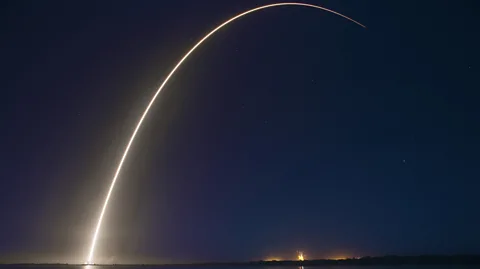 SpaceX/ Public Domain
SpaceX/ Public DomainOn March 22 1990 Bull was shot three times in the back and twice in the head as he entered his Brussels apartment. No one witnessed his assassination – the gun was silenced – and a killer was never identified. In the months before his killing, Bull’s flat was broken into on several occasions. With hindsight, this might have been a warning of what was to come. The New York Times reported that when police arrived at the scene they found the key still in his door and his unopened briefcase containing nearly $20,000 in cash.
It’s not known who killed him. The Israeli intelligence agency, Mossad, was linked with the assassination of Bull, not because of the supergun directly, but because of the work he was doing additionally to improve Iraq’s ballistic missile technology. Others linked the US, UK and South African intelligence services, as well as Iraq themselves.
After his death, Project Babylon went cold. Two weeks later, UK customs seized supergun components leaving the port of Teesport. Iraq invaded Kuwait shortly after and that ended Western involvement with the Iraqi regime.
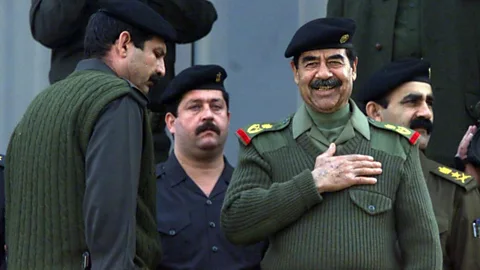 Getty Images
Getty ImagesSo could superguns ever make a return? Some have tried. In 2009, Hunter and two other colleagues began a new venture off the back of Sharp. The project was called Quicklaunch, and it hoped to use hydrogen-powered gas guns to fire fuel to space station depots for use in manned spaceflight to the Moon and to Mars.
The launcher was designed to be 1,100m long and to float in the ocean almost entirely underwater with only the 3m wide muzzle projecting above the waves. The advantage of this over all the earlier land-based designs is that the gun could be moved and angled easily, allowing more than one launch a day to different orbits. Hunter even suggests, in this Google Tech Talk from 2009, that the gun could launch a payload every two hours.
However, the project never really got going because of “internal issues”, according to Hunter. “It’s no more. There’s some intellectual property there but the members have split up.”
It also looks unlikely that any supergun projects will restart given that Space X’s reusable rocket launchers have been dominating the headlines. “For now, with the work Elon Musk is doing with Space X there’s no room for a project like Quicklaunch,” says Hunter. “But I’m happy as a clam for Elon, I really am, because it takes the monkey off my back.”
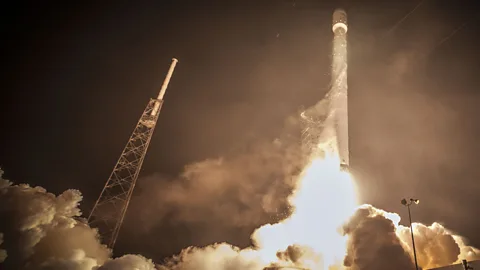 SpaceX/Public Domain
SpaceX/Public DomainSomeone with Musk’s financial clout could explore superguns if he wanted, Hunter adds, but it’s probably not in his interest to undercut his efforts with rockets. “Elon is a smart businessman, he understands that if he pursued a less conventional method he would lose the backing he has,” he says. “He would rock the boat too much. He would lose his base. It would be a mistake to support this even if he knows the physics is right.”
There’s also the fact that Bull clouded the potential of superguns by his choice of politically controversial backers. “There’s a stigma around superguns that mean they are unlikely to be considered even if they’re a better technology for launching satellites,” says Hall.
Hunter is optimistic about the future though. “I think we’ll see superguns again. There’s a chance that I will take it forward if Elon drops the ball, but for now we need too many miracles for it to work out.”
However, a handful of universities and research facilities around the world do still use supergun-like technology on a smaller scale for aerospace engineering. Only not to launch satellites, but to test high-speed impacts of space debris on satellites’ protective layers.
The gif above shows high-speed impact of a 1cm diameter aluminium projectile on 3mm aluminium satellite shielding – essentially the same protection used on the International Space Station – at 6.5km/s (Credit: Andrew Higgins)
“I operate a gun in my lab here at McGill that is nudging up to 11 km/s (almost escape velocity),” says Higgins. And there are even plans to design guns that reach up to 15km/s. These incredible speeds are needed to test what happens when tiny fragments of space debris strike the outer layers of satellites, something not possible to achieve without these high-powered gas guns. So while no satellites are being launched with Bull’s technology, it is being used to protect the ones that are already up there.
Meanwhile, the remaining parts of Bull’s supergun are mostly sitting in storage, or in museum displays. At the end of the war the UN seized and destroyed the one working Baby Babylon prototype and the remaining components of the two Big Babylon guns, as well as evidence of Iraqi designs for their own supergun.
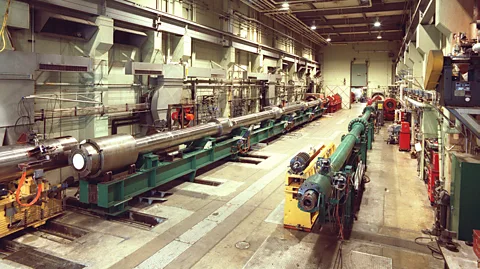 US Air Force/ Public Domain
US Air Force/ Public DomainSome parts survived though: those seized by UK customs. “After they were not needed as evidence, they would normally have been sold or cut up,” says Hall. “Because customs were interested in the story, they arranged for some of the pipes to be given to museums, and the MOD kept some.”
To the outside eye, those two giant cylinders in the Royal Armoury don’t look like much – you could mistake them for an oil pipe – but these chunks of metal are some of the last remaining fragments of Gerald Bull’s legacy: a man whose dreams of aiming high brought him crashing back to Earth.
--
William Park is BBC Future’s social media producer. He tweets at @williamhpark.
Join 500,000+ Future fans by liking us on Facebook, or follow us on Twitter, Google+, LinkedIn and Instagram.
If you liked this story, sign up for the weekly bbc.com features newsletter, called “If You Only Read 6 Things This Week”. A handpicked selection of stories from BBC Future, Earth, Culture, Capital, Travel and Autos, delivered to your inbox every Friday.
